... bodes the death of the rose
The so-called Nerdrum School, the Norwegian new-traditional school of
painting, includes a stylistic feature that has always seemed foreign to
me, namely a striving for exactness. When painting a hand, how interesting
is it to achieve anatomical correctness as long as the image is not imbued
with life? I think this observation can be generalized, and it has forced
the more independent talents among young figurative painters to move beyond
academicism and toward expression and stylization. Both Baroque-influenced
Thomas Knarvik and the increasingly minimalistic Sverre Koren Bjertnæs
have moved in this direction, and - although steering a middle course
- the Swedish artist Christopher Rådlund has as well. Of course there
are motifs and motifs. "Paint me a rooster", the Chinese emperor commanded
his eighty-year-old rooster painter while the palace guard pushed the artist
to the floor beneath a raised sword. Legend has it the result was dazzling,
but one cannot capture all motifs in a few lines like one can a rooster,
(a wind-torn pine, a mountain). Not the motif of the human figure. Our
signs can carry everything except ourselves. In my opinion, it is precisely
in his paintings of infants that Odd Nerdrum, in his slightly finical manner,
comes closest to a timeless mastery. These paintings are form and light,
but also entirely their motif's content.

The human figure is currently absent in the motif world of Christopher
Rådlund, and I believe this is related to the problems raised above.
Many years ago, I saw huge charcoal drawings by C.R. at the Södertälje
Konsthall. On them, human bodies come to life and open up. They are kindred
to Käte Kollwitz's pictures, but in contrast to hers, movement is
directed outward, not inward, not toward the body. Like a sailing ship
with rigged sails, the figures in these pictures glided ever further away
from the artist, and he has since then moved on to picture solutions which
exclude the human figure entirely. Now whatever he wishes to express about
us and our situation must be said with the help of external objects in
traditional genres, the landscape and the still life. But can one call
his skull motif, the cranium, an external object? Like a tankard or a bone-white
cup it rests there, inside our identity's cheeks and eyes. Anonymous down
to its hard core, but personally carried out. Just as one can see in the
old masters (Titian, Velazques, Goya...), the skull on the canvass becomes
more than a skull. It has a surplus, like a lamp. The mystery in the picture's
skull is how these wide, organic, almost plantlike lines are able to create
a crystalline brittleness. It belongs at the same time to the human sphere
as it does to the sphere of nature. Is this then the final word about man,
that he is in fact nature? All the same it is difficult to discover any
classical, nature-tuned harmony in the aggressive jaw that sinks its remaining
teeth into the green dark of evening, before the night's shower of ashes.
Irrespective of the picture's "natural" motif, we are reminded that painting
is always culture and culture is always decadent. Yet another transformation;
the nature painter reveals himself as a commentator on the contemporary.
In the armour-bright "Hav" ("Ocean"), the perspective of infinity becomes
intimate and nauseating. Twilight and daybreak lie in wait for each other
- the snake that is about to bite its own tail. The observer feels both
hope and imminent catastrophe. This is truly a painting for the turn of
the millennium.
Like the romantic churchyard painters of bygone centuries, C.R. is
above all an elegist. Despite their lyrical qualities, his many cloud pictures
are executed with monotonous gloom. His roses are relics of roses, his
landscapes songs of mourning for lost landscapes. In her book Soleil
Noir - Dépression et Mélancholie, Julia Kristeva asks
whether disillusion can be beautiful. In her answer, Kristeva points to
a historical example, the Lutheran uprising, and how artists like Hans
Holbein did not want his drawings to glorify the gold and finery of the
rich. She writes: "A new idea was born in Europe ... the idea that the
truth is austere". This observation led Kristeva to consider the social
protest that sorrow can contain. C.R. wrote to me while traveling on a
grant to Scotland, Wales and Ireland. I saved a letter of his from Ireland.
He is full of sarcasm: "Celtic mood, Celtic spirit, Celtic life and so
forth. Mildly put a bit exhausting for a pilgrim. I hadn't realized I was
going to visit Holy Lands, not this cheap and easy sleight of hand with
myths and heritage. The future? Dublin will change its name to Bodhran
(the hand-drum in traditional Irish music) and hamburgers will be sold
under the name McCeltic". It wouldn't be difficult to translate his critique
to Scandinavian conditions. How everything down to the most genuine (be
it the Hardanger, fjeld-rapids or Odd Nerdrum paintings) is transformed
into the shabbiest form of commerce.
For C.R.'s most recent exhibition in Oslo, the artist requested a calligrapher
to decorate the posters announcing it with classicizing calligraphy, using
these lines by the Swedish poet Pär Lagerkvist: "Let my shadow disappear
in yours / Let me lose myself / Beneath those great trees / They who entrust
themselves / To the heavens and to night." This is reminiscent of the two-way
movement in any artist's protest. On the one hand there is a lingering
in the sorrow of the self and a negation of the world (as it appears),
and on the other hand an unconditional capitulation before nature or the
powers of nature. To my mind, this intrinsic inner conflict is most clearly
addressed in the paintings of rose stems. Their dried-up brittleness makes
me think of Giacometti, who would study dust formations in his atelier.
In his article "L'atelier d'Alberto Giacometti", Jean Genet writes of an
art that must move through the porous walls of the shadow realm. Genet,
who did not love roses, but did love the word "rose", has all the same
seen their pale light. I see it. It is like the backlit chinks around a
heavy door. Like Juliet's young lips when she awakens in the Capulet's
family grave. Coke cans are red, but lips are grey. "Her weeping was the
weeping of roses. I saw it." (Sigbjørn Obstfelder).

|

![]() © 2003-2005 Ars Interpres Publications.
© 2003-2005 Ars Interpres Publications.